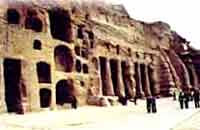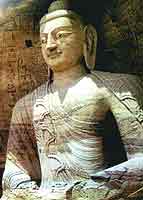 |
|
| Yungang Grottoes |
| CCTV.COM 2002-09-03 13:09:07 |
|
 In 1973, French President Pompidou, ailing with cancer, decided to come to China. He wanted to see China's grottoes, Yungang Grottoes in particular, although he had a tight schedule of state activities. He realized his wish in the company of Premier Zhou Enlai. In 1973, French President Pompidou, ailing with cancer, decided to come to China. He wanted to see China's grottoes, Yungang Grottoes in particular, although he had a tight schedule of state activities. He realized his wish in the company of Premier Zhou Enlai.
One of three grottoes in China, Yungang is situated in the western suburbs of Datong, Shanxi. Its construction began in the 5th century in the Northern Wei Dynasty about 1,500 years ago. The first five caves, being dug under the direction of Monk Tan Yao, were called "Tan Yao's Five Caves". To please the emperor, Tan Yao made his five big Buddhas resemble the Wei emperors in features. All dominating Buddhas were over 13 meters in height. Their tall majestic stature represented the almighty power of Buddha and emperor.
The giant Buddha sitting in the open in Cave 20 is representative of work done in the earlier stage. Foreign characteristics are obvious in his features and garment. He has a broad forehead, long and narrow eyebrows, a high nose-bridge, and mouth showing great depth. He wears a kasaya that leaves his right shoulder uncovered. The lines of his garment indicate that it is made of woolen fabric. These are characteristics of people in the northwest of India, the north of Pakistan and in Afghanistan.
Carvings in Yungang Grottoes also manifest the amalgamation of foreign and Chinese cultures. Architectures are carved with a Chinese bracket system called "dougong". We also see decorations of Indian golden-winged birds. There are also decorative patterns of Chinese balustrades and Persian acanthus. We can see a pagoda with many layers of eaves in the Chinese style, or a cave having columns in the front like Greek architectures.
These carvings with a Western flavor belong to the ancient Indian Gandhara style. In the 4th century BC, Alexander of Macedonia went on an expedition to central Asia, bringing the influence of Greek culture with him. Ancient India incorporated Greek and Buddhist carving art and produced Gandhara art that, together with Buddhism, found its way into China through the Silk Road.
In the middle stage of Yungang Grottoes, apart from a richer content in its carvings, the features and garments of the Buddhas gradually took on an oriental flavor. The Buddhist statues are clothed in ample gowns and loose girdles like Chinese officials. Buddhas no longer bared their right shoulders. They wore long pleated skirts and flowing drapes like garments of Han aristocrats in the south.
Yungang Grottoes inherited and developed the traditional art of Qin and Han dynasties. It also absorbed the essence of foreign culture and created a unique style that served as a connecting link to the later Sui and Tang-dynasty art. Yungang Grottoes is the fruit created by the many nationalities in China. It is also an evidence of cultural exchanges between China and foreign countries.
 The attraction of Yungang Grottoes lies in its large number of vivid carvings of Buddhist statues and niches. Following the art tradition of Qin and Han it achieved plausible results with its numerous captivating images. The attraction of Yungang Grottoes lies in its large number of vivid carvings of Buddhist statues and niches. Following the art tradition of Qin and Han it achieved plausible results with its numerous captivating images.
There are stories about Buddha's earlier incarnations and other Buddhist stories. Like Sanzi taking care of his blind parents and how Sakyamuni left home and his incarnation. These stories unroll like serials before the viewers.
Cave No. 5 houses the largest statue. It is 17 meters high, its crossed legs measure 4.6 meters and the middle finger 2.3 meters. When carving a statue as big as this, it is very difficult to follow a good proportion. The statue is evidence of the carving technique of 1,500 years ago.
Cave No. 6 is very spectacular. Its 16-meter high walls and the pagoda in the middle are covered with carvings. There are statues of Buddhas and Buddhisattvas, disciples, Buddhist devotees, Buddhist stories, architectures, animals and plants, and many kinds of decorative patterns.
Cave No. 12 is regarded the musical cave. Here we see Buddhist devotees and gods of music and dance. The musical instruments in their hands like the plucked instrument "konghou" and "pipa" and waist drums were introduced from central Asia while panpipes and plucked zithers like "qin" and "zheng" were originated in China. The cave offers good material for researches on ancient China's music and dance.
Yungang Grottoes also supplies visual material for the study of China's history of Buddhism, music and art. It also reflects the friendly exchanges between the peoples of China and Asia. Yungang Grottoes is a treasure house of China and of mankind.
|
|
Editor: Liu Baoyin CCTV.com
|
|
|
|
|
|
 |









